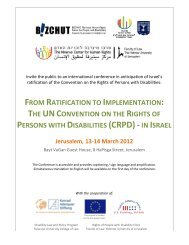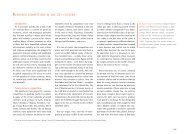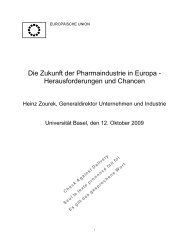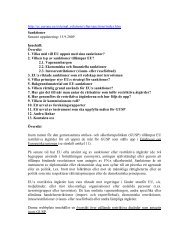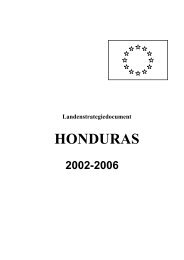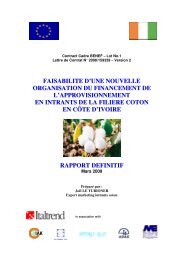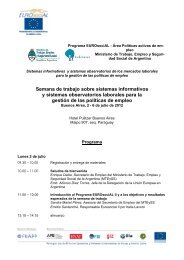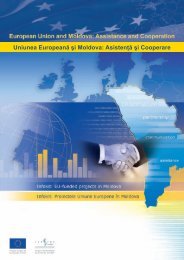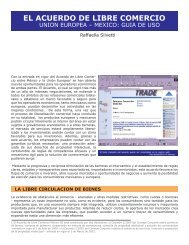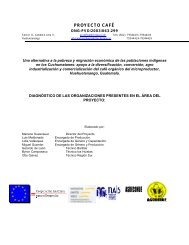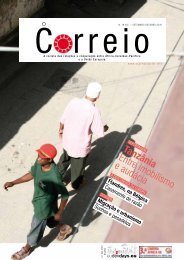Regional Reports - the European External Action Service
Regional Reports - the European External Action Service
Regional Reports - the European External Action Service
Create successful ePaper yourself
Turn your PDF publications into a flip-book with our unique Google optimized e-Paper software.
mobilization than NGOs lobbying and advocacy.<br />
2) The study identified that World Vision and <strong>Action</strong> Aid which were working on human<br />
rights are some of <strong>the</strong> large international NGOs present while <strong>the</strong> Ethiopian Women<br />
Lawyers Association and Progynist working on human right and women empowerment<br />
were taken as some “interesting” Ethiopian NGOs<br />
3) The Ethiopian Pastoralists Research and Development Association has been identified as<br />
an example of NGOs working on conflict resolution and many faith-based organizations<br />
present in <strong>the</strong> SNNPR are mainly working on development more than in o<strong>the</strong>r regions.<br />
4) However, instead of stating ‘some NGOs’ or ‘o<strong>the</strong>r small’ or “unnamed organisations”,<br />
<strong>the</strong> study should have clarified NGOs which <strong>the</strong> Government spokesperson referred to as<br />
exemplary for effective lobbying and advocacy and/or conflict resolution between Omo<br />
and Oromia people s but does not clarify <strong>the</strong> which NGOs.<br />
5) SEPDA is <strong>the</strong> main development association which is an umbrella organization for 21<br />
mostly ethnic based smaller development associations which it assists in capacity<br />
building, fund raising and project proposal preparation. According to <strong>the</strong> study, SEPDA<br />
works differently…..because its inputs appear to have fewer acceptances in government<br />
policy making.<br />
1.3. Major highlights of current findings<br />
• SNNPR is endowed with NSA of diverse nature including CSO such as CBO including<br />
Iddir, self-help associations and also interest groups organized by age and sex like youth<br />
and women associations as well as clubs such as anti-HIV/AIDS, environmental, etc. There<br />
are also local and regional development associations, cooperative organizations and unions,<br />
savings and credit, labour unions and professional associations.<br />
• NGOs are <strong>the</strong> most active NSA which are large in number and diverse in typology, sector<br />
and <strong>the</strong>matic area as well as coverage. Currently <strong>the</strong>re are nearly 115 NGO operational in<br />
<strong>the</strong> region while <strong>the</strong> on-going project activities are about 336 covering a wide range of<br />
sector and <strong>the</strong>matic areas. In terms of <strong>the</strong>ir typology, <strong>the</strong>re are 70 national NGOs 28<br />
international NGOs while <strong>the</strong> remaining 17 are FBO.<br />
• Even though NGOs mobilize enormous resources and reach a large beneficiary population,<br />
<strong>the</strong>re is inconsistency in <strong>the</strong> estimates of project budget and <strong>the</strong> number of beneficiaries<br />
served. On <strong>the</strong> basis of <strong>the</strong> DPPA data, <strong>the</strong> total NGO project budget for <strong>the</strong> period 2004 –<br />
2007 is about 1.47 million Birr and over 47 million project beneficiaries. According to <strong>the</strong><br />
SNNPR BoFED however, <strong>the</strong> estimate of on-going project budget and <strong>the</strong> total number of<br />
beneficiaries are about one billion Birr and nearly 12.7 million respectively. Never<strong>the</strong>less, a<br />
single NGO alone, like World Vision has over 1.2 million project beneficiaries and<br />
mobilizes over USD 1.4 million or about 12.8 million Birr. Thus, <strong>the</strong> inconsistency appears<br />
to have emanated ei<strong>the</strong>r due to <strong>the</strong> weakness of <strong>the</strong> MIS in use or <strong>the</strong> intention to<br />
overshadow <strong>the</strong> resource potential and role of NGO as development partners.<br />
• Never<strong>the</strong>less, <strong>the</strong> regional state including sector bureaus do recognize <strong>the</strong> important role<br />
and also <strong>the</strong> significance of NGOs contribution in <strong>the</strong> development endeavours of <strong>the</strong><br />
SNNPR. Their participation and contribution is well recognized specially in <strong>the</strong> sectors that<br />
include agriculture and agro-pastoral, food security and emergency programmes, water and<br />
sanitation, education and health which are pro-poor and community based on-going<br />
projects. They also undertake project activities that target marginalized groups and <strong>the</strong><br />
79




